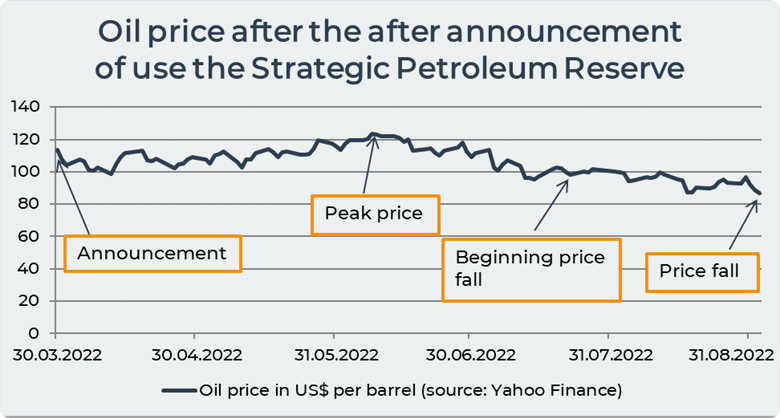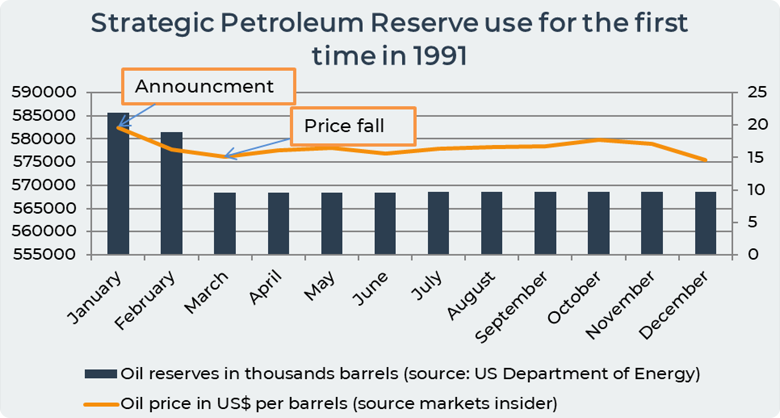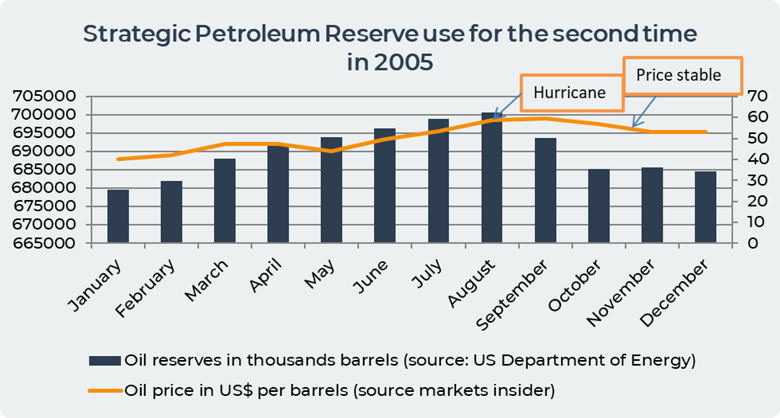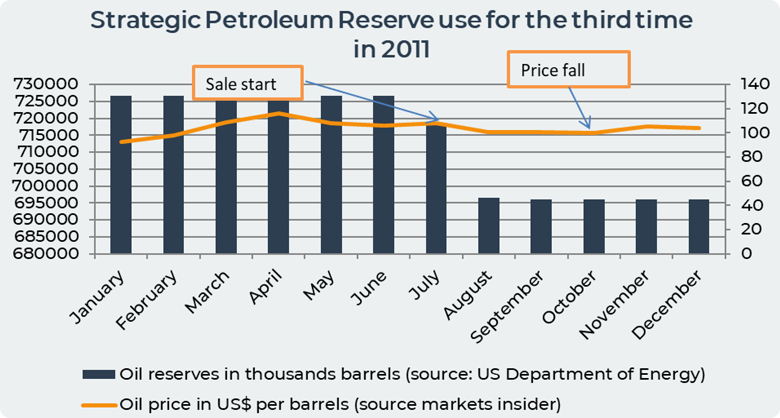Why is the United States using the Strategic Petroleum Reserve?
Introduction: The US Strategic Petroleum Reserve
After Russia's invasion of Ukraine, oil prices rose sharply. In response to the energy crisis, Joe Biden decided to use the Strategic Petroleum Reserve. The main idea of the article is to understand the essence of using the Strategic Petroleum Reserve.
In the first chapter, we will show that the US will use the maximum capacity in its strategic petroleum reserve.
In the second chapter, we will show that the strategic petroleum reserve was used only three times in the history.
In the third chapter, we will show that only the president has the right to use the strategic petroleum reserve.
1. Joe Biden Released 180 Million Barrels of Oil From the US Strategic Petroleum Reserve.
Domestically, the Biden administration is under pressure. Midterm elections are to be held in the USA in the fall, and the Democrats risk losing their majority. Republicans blame Biden for skyrocketing inflation and the rising cost of living. Record-high fuel prices for cars, which are putting more pressure on the American middle class, are a pain for the president.
From September 2021, gas prices began to rise sharply. In November 2021, President Biden decided to release 50 million barrels together with other countries. However, these actions did not give the desired result and prices continued to rise as restrictions were imposed on the export of Russian energy.
On March 31, 2022, in response to rising oil prices, the White House announced that it would begin using its oil reserves in a historic amount of 180 million barrels. These actions were an attempt to lower gas prices. "Our prices are rising because of Putin's actions. There isn't enough supply. And the bottom line is if we want lower gas prices we need to have more oil supply right now," Biden said.
The largest oil release in history will serve as a "wartime bridge" according to Biden. The decision was made together with the US allies. "Together, our combined efforts will supply well over a million barrels a day. Nations are coming together to deny Putin the ability to weaponize his energy resources against American families and families and democracies around the world," Biden said. Biden also added that he will replenish oil reserves when oil prices fall, which will encourage more oil production.
The second part of President Biden's plan is to create long-term US energy independence. "Ultimately, we and the whole world need to reduce our dependence on fossil fuels altogether. We need to choose long-term security over energy and climate vulnerability," Biden said.

The graph above shows that the US Strategic Petroleum Reserve is at the level of 1985. After Biden began releasing barrels from November 2021, oil reserves began to decline sharply. As of June 2022, oil reserves amounted to 49324 thousand barrels (51.8 US$ Billions).
The graph below shows that immediately after the announcement of the use of reserves, the price of oil fell by 4.8%, but on April 12, 2022, the price of oil rose again by 10.44%. During April-June 2022, the United States and its allies failed to lower the price of oil below 100US$ per barrel. The price of oil fluctuated in the range of more than 100US$ dollars per barrel and reached its peak in mid-June 2022, from 7 to 14 June when the price was above 120US$ dollars per barrel. Since mid-July 2022, the price of oil has fallen below 100US$ per barrel and as of September 2, 2022 is $86.56 per barrel, which is 24% cheaper than on March 30, when it became known that Biden would announce the use of the US Strategic Petroleum Reserve.

1.1. Joe Biden can use the Strategic Petroleum Reserve for six months.
According to the Energy Policy and Conservation Act (EPCA) already in place in the Energy Department of the USA, the president can use strategic petroleum reserves during 180 days. Oil can be pumped out of storage at a maximum rate of 4.4 million barrels per day for 90 days. Then the extraction rate starts to decrease as the vaults become empty. Joe Biden announced that he will release 1 million barrels of oil per day for 180 days. With such releases, the Reserve can release oil continuously for almost half a year.
2. The Strategic Petroleum Reserve has Only Been Used Three Times in History.
The Strategic Petroleum Reserve has only been used three times in history in 1991 by President George H. W. Bush, in 2005 by George W. Bush, and in 2011 by President Barack Obama.
On January 16, 1991, during the Gulf War, US President George H. W. Bush announced that the Strategic Petroleum Reserve would immediately begin selling 2.5 million barrels per day. The next day, the price of crude oil fell by a third and was 10.56US$ per barrel. The shocking drop in prices prompted several oil companies to announce immediate price cuts.

When the price fell below 20US$ per barrel in February-March 1991, the Strategic Petroleum Reserve stopped releasing oil and sold only 17 million barrels ($272 million). After this event, the price of crude oil did not rise above 20US$ per barrel for the next 5 years until December 1996 when the price of crude oil was 21.3US$ per barrel.
From August 23, 2005 to August 31, 2005, the United States faced one of the most destructive hurricanes in its history - Hurricane Katrina. Oil reserves are stored in the Gulf of Mexico, which was hit by Hurricane Katrina. Katrina caused significant damage to the strategic oil reserve. The hurricane shut down 95% of crude oil production and 88% of gas production in the Gulf of Mexico. At the time, it was a quarter of all US production. About 730 gas and oil rigs and platforms were evacuated due to the hurricane.

George W. Bush announced the sale of oil because of Hurricane Katrina. The graph above shows that the sales were in September 2005, which allowed to stabilize the price first by 5% in October 2005 and then by another 8% in November 2005 when the price of oil was 53.20 US$ dollars per barrel. The US sold 11 million barrels of oil during Hurricane Katrina and received 627 US$ millions.
In 2011, during the Arab Spring, oil production in Libya decreased sharply. The first civil war started in February 2011 and ended by October 2011, which practically stopped the production of crude oil.
In June 2011, Barack Obama announced a non-emergency sale of oil together with IEA partners to compensate for disruptions caused by the civil war in Libya and other upheavals in the Middle East.

The graph above shows that the US sold 30 million barrels (2.97 US$ billions) in the period June-September 2011. Together with IEA partners, the USA released 60 million barrels (5.94 US$ billions). This sale of oil reduced its price by 8% from 108 US$ per barrel in July 2011 to 100 US$ per barrel in October 2011.
3. When and Who Can Use the Strategic Oil Reserve?
The strategic petroleum reserve is an emergency oil reserve kept by the United States Department of Energy. The reserves are located in the Gulf of Mexico - Louisiana and Texas. There are 4 objects where oil reserves are stored: Bryan Mound, Big Hill, West Hackberry and Bayou Choctaw.
The strategic petroleum reserve was created after the oil shock in 1973. Access to the reserve is determined by the conditions described in the Energy Policy and Conservation Act, which was created in 1975. According to the law, the maximum rate of oil extraction is 4.4 million barrels per day. The only person who can announce the release of oil is the president. The Minister of Energy also has some limited powers to sell oil. Oil begins to enter the market 13 days after the president's announcement.
There are three possible examples for using a strategic petroleum reserve:
- Full drawdown - the president can issue a decree on the complete reduction of the reserve to counter "severe energy supply interruption." The Energy Policy and Conservation Act defines it as "a national energy supply shortage."
- Limited drawdown - there is a threat that can lead to a deficit of energy supply of a significant scale and duration.
- Test sale or exchange - the Minister of Energy has the authority to carry out selective test sales and distribution of oil from the reserve. He also has the authority to exchange oil, but within a certain time the oil must be returned to the reserve.
Conclusion
Faced with a sharp rise in energy prices due to sanctions against Russia, the United States began to use its strategic petroleum reserve in an unprecedented amount. Never in the history of the United States has the reserve been used in such circumstances, which creates even greater challenges for American dominance in the field of energy pricing. Only three times in history has the US used its reserves. These steps had a certain impact on the price of oil.
The US released announced 180 million barrels of oil from its reserves to reduce the price of oil in the world in 2022. By releasing one million barrels per day from their reserves, the US and its allies managed to reduce the price of oil below 90 US$ dollars per barrel in September 2022.
Date= 6th September 2022, Gold price – 1722.10$, Silver price – 18.29$, Platinum price – 867.30$, Oil price – 86.79$


